High Impact Tutoring Built By Math Experts
Personalized standards-aligned one-on-one math tutoring for schools and districts
In order to access this I need to be confident with:
Probability Probability notation How to find probability Tree diagram probability Fractions Decimals Independent events Mutually exclusive events Venn diagrams Two-way tablesConditional probability
Here you will learn about conditional probability, including the definition of conditional probability and how to calculate probabilities when there are conditional elements.
Students will first learn about conditional probability as part of statistics and probability in 7 th grade.
What is conditional probability?
Conditional probability is the probability of an event occurring based on the occurrence of another event. Conditional probability is a fundamental aspect of probability theory.
Conditional probability questions often involve picking two objects from a set. This is because once you have picked the first object, the probabilities change for the second pick, based on the outcome of the first pick.
For example,
You have a bag containing 3 red marbles and 4 blue marbles.

The probabilities of picking each color marble are,
P(\text{red marble})=\cfrac{3}{7} P(\text{blue marble})=\cfrac{4}{7}If you picked out one red marble, there would be 2 red marbles and 4 blue marbles left.

The probabilities would now be,
P(\text{red marble})=\cfrac{2}{6} P(\text{blue marble})=\cfrac{4}{6}If instead, you picked out one blue marble, there would be 3 red marbles and 3 blue marbles left.

The probabilities would now be,
P(\text{red marble})=\cfrac{3}{6} P(\text{blue marble})=\cfrac{3}{6}![[FREE] Probability Worksheet (Grade 7 to 12)](https://thirdspacelearning.com/wp-content/uploads/2023/07/Probability-check-for-understanding-quiz-listing-image.png)
[FREE] Probability Worksheet (Grade 7 to 12)
![[FREE] Probability Worksheet (Grade 7 to 12)](https://thirdspacelearning.com/wp-content/uploads/2023/07/Probability-check-for-understanding-quiz-listing-image.png)
Use this quiz to check your grade 7 to 12 students’ understanding of probability. 15+ questions with answers covering a range of 7th to 12th grade probability topics to identify areas of strength and support!
DOWNLOAD FREE![[FREE] Probability Worksheet (Grade 7 to 12)](https://thirdspacelearning.com/wp-content/uploads/2023/07/Probability-check-for-understanding-quiz-listing-image.png)
[FREE] Probability Worksheet (Grade 7 to 12)
![[FREE] Probability Worksheet (Grade 7 to 12)](https://thirdspacelearning.com/wp-content/uploads/2023/07/Probability-check-for-understanding-quiz-listing-image.png)
Use this quiz to check your grade 7 to 12 students’ understanding of probability. 15+ questions with answers covering a range of 7th to 12th grade probability topics to identify areas of strength and support!
DOWNLOAD FREEThe probabilities are calculated based on what has already occurred.
Event A could be the outcome of the first pick (example, picking a red ball).
Event B could be the outcome of the second pick (example, picking a blue ball after picking a red ball).
Conditional probability P(A|B) represents the probability of A given B has already occurred. In the context of picking objects sequentially from a set, it means calculating the probability of picking a second object (Event B ) under the condition that a first object (Event A ) has already been picked.
The outcome of the first pick or previous event (Event A ) influences the probability of Event B, illustrating the dependence between these events in sequential scenarios.
Remember: The probability of an event happening is calculated using:
P(\text{Event})=\cfrac{\text{number of desired outcomes}}{\text{total number of outcomes}}What is conditional probability?
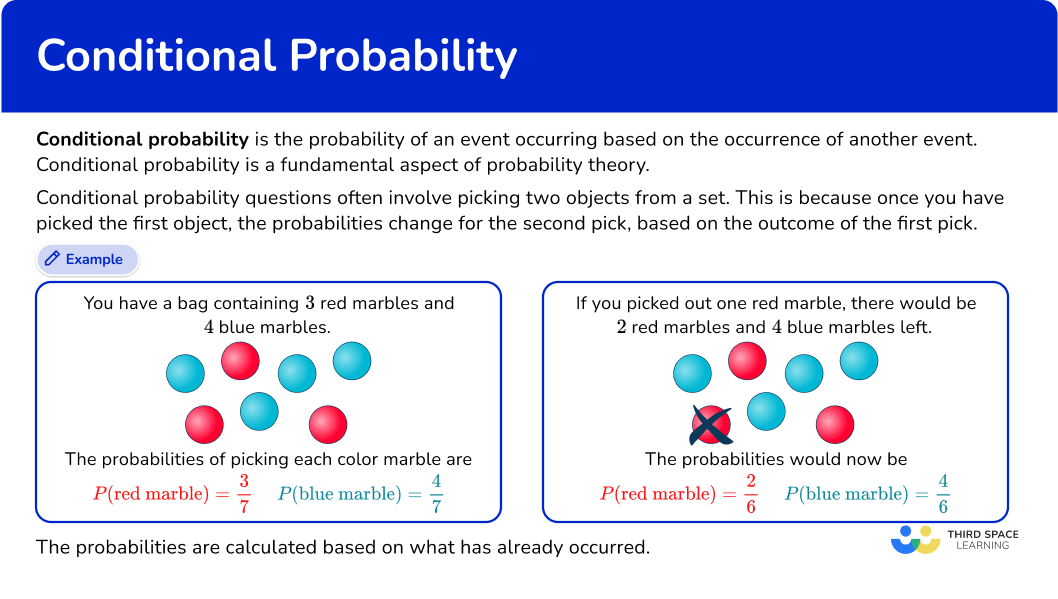
Common Core State Standards
How does this relate to 7 th grade math?
- Grade 7 – Statistics and Probability (7.SP.C.8)
Find probabilities of compound events using organized lists, tables, tree diagrams, and simulation.
How to calculate conditional probability
In order to calculate conditional probability:
- Identify the number of desired outcomes under the condition.
- Identify the total number of outcomes under the condition.
- Write the probability.
Conditional probability examples
Example 1: using a Venn diagram
The diagram below shows the results when 25 students were asked whether they can speak French or Spanish.
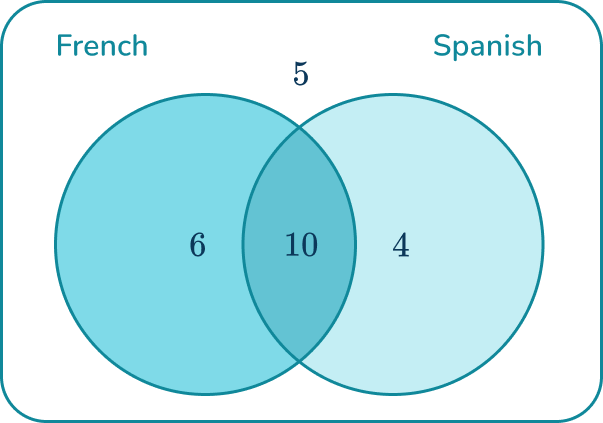
A student is chosen at random. Find the probability that the student can speak French given that they can speak Spanish.
- Identify the number of desired outcomes under the condition.
The desired outcome here is that the student speaks French. (Event A )
The condition is that they speak Spanish. (Event B )
You need to find the conditional probability of A given B, which is to identify the number of students who speak French and Spanish.
There are 10 students who speak French and Spanish.
This will be the numerator of our fraction.
2Identify the total number of outcomes under the condition.
The condition is that they speak Spanish, so you need to consider all the students who speak Spanish.
There are 10+4=14 students who speak Spanish.
This will be the denominator of our fraction.
3Write the probability.
P(\text{Event})=\cfrac{\text{number of desired outcomes}}{\text{total number of outcomes}}=\cfrac{10}{14}Example 2: using a two-way table
The table below shows the hair and eye color of a group of people.

A person from the group is chosen at random. Find the probability that the person has blonde hair given that they have blue eyes.
Identify the number of desired outcomes under the condition.
The desired outcome here is that the person has blonde hair.
The condition is that they have blue eyes.
You need to identify the number of people who have blonde hair and blue eyes.
8 people have blonde hair and blue eyes.
Identify the total number of outcomes under the condition.
The condition is that the person has blue eyes.
There are 8+3+5=16 people with blue eyes.
Write the probability.
Example 3: probability of one event given another event has occurred
A bag contains 6 blue balls and 10 yellow balls. One ball is picked and it is yellow. A second ball is then picked. Find the probability that the second ball is yellow given that the first ball was yellow.
Identify the number of desired outcomes under the condition.
The desired outcome here is picking a yellow ball.
The condition is that 1 yellow ball has already been picked.
Given that 1 yellow ball has already been picked, there are now 9 yellow balls.
Identify the total number of outcomes under the condition.
The condition is that 1 yellow ball has already been picked.
Given that there were 16 balls to begin with and 1 has already been picked, there are 15 balls remaining.
Write the probability.
Example 4: probability of one event given another event
Lauren has a deck of cards. Lauren draws one card from the deck. The card she draws is an ace. Lauren then picks a second card. Find the probability that the second card is not an ace given the first card was an ace.
Identify the number of desired outcomes under the condition.
The desired outcome here is not picking an ace.
The condition or preceding event is that one ace has already been picked.
There are 52 cards in a deck of cards, 4 of the cards are aces.
Given that there were originally 48 cards that were not aces and it is an ace that has been picked, there are still 48 cards that are not aces.
Identify the total number of outcomes under the condition.
The condition is that one ace has been picked. If one card has been picked from the original 52 cards, there are a total of 51 cards left.
Write the probability.
Example 5: probability of two events using a tree diagram
There are 12 socks in a drawer. 4 are white and 8 are black. William picks one sock and then picks a second sock. Find the probability that both socks are white.
Identify the number of desired outcomes under the condition.
You can draw a tree diagram to represent the possible outcomes:
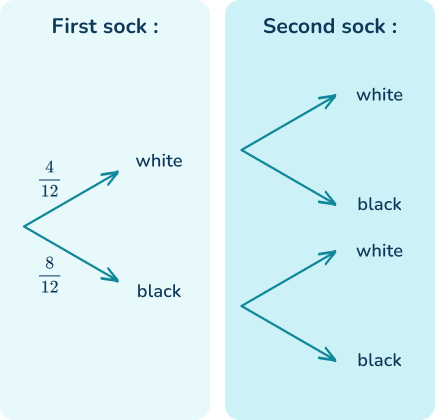
Since there are 12 socks to begin with, 4 of them white and 8 black, the probability of picking a white sock on the first pick is \cfrac{4}{12} and the probability of picking a black sock is \cfrac{8}{12}.
The probabilities for the second pick need to be calculated given the condition that the first pick has already occurred.
Identify the total number of outcomes under the condition.
Let’s first assume that the first pick was a white sock. If a white sock has already been picked there are now 3 white socks and 8 black socks. There are now 11 socks left altogether.
P(\text{Event})=\cfrac{\text{number of desired outcomes}}{\text{total number of outcomes}}
P(\text{White sock})=\cfrac{3}{11}
P(\text{Black sock})=\cfrac{8}{11}
Write the probability.
Now let’s assume the first sock was black. If a black sock has already been picked there are now 4 white socks and 7 black socks. There are now 11 socks left altogether.
P(\text{Event})=\cfrac{\text{number of desired outcomes}}{\text{total number of outcomes}}
P(\text{White sock})=\cfrac{4}{11}
P(\text{Black sock})=\cfrac{7}{11}
You can now fill the rest of the tree diagram:
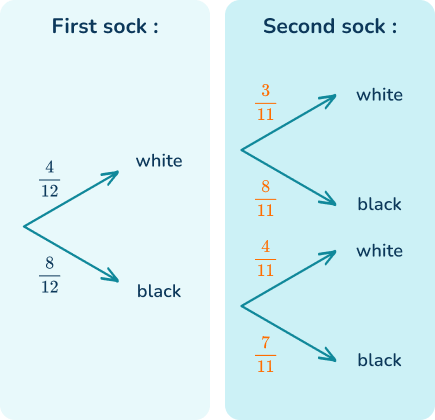
To find the joint probability that both socks are white, you use P(A\cap{B})=P(A)\times{P(B)} , which is the multiplication rule of probability.
Example 6: probability of two events using a tree diagram
Karam has a box of chocolates containing 14 milk chocolates and 6 white chocolates. Karam eats 2 chocolates. Find the probability that Karam eats two chocolates of the same type.
Identify the number of desired outcomes under the condition.
You can represent this using a tree diagram.
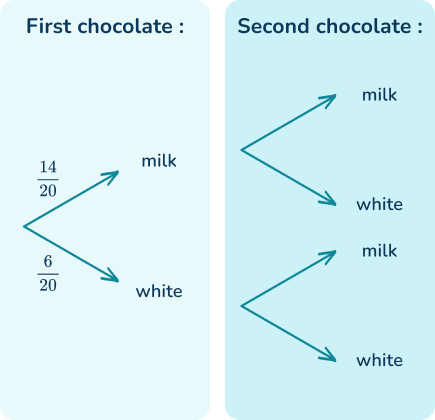
You need to work out the probabilities for the second chocolate.
Identify the total number of outcomes under the condition.
If the first chocolate was milk, then there are 13 milk chocolates and 6 white chocolates left. There are 19 chocolates left.
P(\text{milk})=\cfrac{13}{19}
P(\text{white})=\cfrac{6}{19}
Write the probability.
If the first chocolate was white then there are 14 milk chocolates and 5 white chocolates left. There are 19 chocolates left.
P(\text{milk})=\cfrac{14}{19}
P(\text{white})=\cfrac{5}{19}
Putting this information on the tree diagram
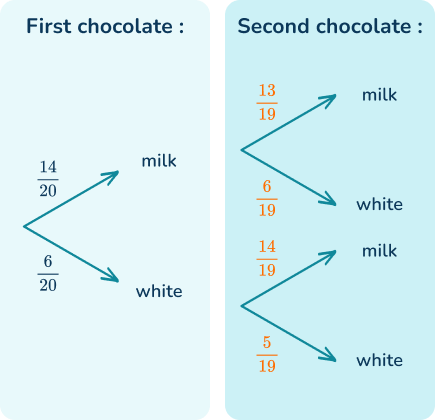
To find the probability that he eats two of the same chocolates, you need the probability that he eats two milk chocolates or two white chocolates.
P(\text{milk and milk})=\cfrac{14}{20}\times\cfrac{13}{19}=\cfrac{182}{380}
P(\text{white and white})=\cfrac{6}{20}\times\cfrac{5}{19}=\cfrac{30}{380}
The probability that Karam eats two of the same type of chocolate is
\cfrac{182}{380}+\cfrac{30}{380}=\cfrac{212}{380}
Teaching tips for conditional probability
- Emphasize that conditional probability is the probability of an event occurring given that another event has already occurred.
- Ensure students understand the notation P(A|B) which means the probability of event A occurring given that event B has occurred.
- Relate conditional probability to concepts they have already learned, such as basic probability, independent and dependent events.
- Introduce calculating conditional probability using the formula of conditional probability: P(A|B)=\cfrac{P(A\cap{B})}{P(B)}. Here, P(A\cap{B}) is the probability of the intersection of A and B, and P(B) is the probability of event B happening.
- Incorporate technology by using online resources to simulate probability problems and online probability calculators to solve them.
- Provide examples so that students can differentiate between conditional probability (events happening given other events) and unconditional probability (individual events occurring independently).
Easy mistakes to make
- Not changing the probability for the second pick when picking two objects
For example, if you have a bag containing 3 blue balls and 7 yellow balls, the probability of picking a blue ball on the first pick is \cfrac{3}{10}.
If a blue ball has been picked on the first pick, then the probability of the event of a blue ball on the second pick is \cfrac{2}{9} because there are 2 blue balls left and 9 balls altogether.
- Incorrect fraction work
Adding, subtracting,multiplying, dividing, or simplifying fractions incorrectly.
- Not simplifying fractions
Usually when you have fractions in math, you simplify them. In probability questions, it may be better to leave fractions in their unsimplified form. This is because you often need to add fractions to solve probability problems.
Remember that fractions need a common denominator in order to add them. Check with the question if you are asked to give your final answer as a fraction in its simplified form or not.
- Mixing “and” with “or” probabilities
An “and” probability is calculated by multiplying the probabilities of two events together:
The probability of picking a milk and another milk chocolate in Example 6 was P(\text{milk and milk})=\cfrac{14}{20}\times\cfrac{13}{19}=\cfrac{182}{380}.
The probability of picking a white and another white chocolate was P(\text{white and white})=\cfrac{6}{20}\times\cfrac{5}{19}=\cfrac{30}{380}.
The probability of picking two milk chocolates or two white chocolates was
\cfrac{182}{380}+\cfrac{30}{380}=\cfrac{212}{380}.
Related probability lessons
Practice conditional probability questions
1. This Venn diagram shows the results when 30 people were asked whether they have a cat or a dog.
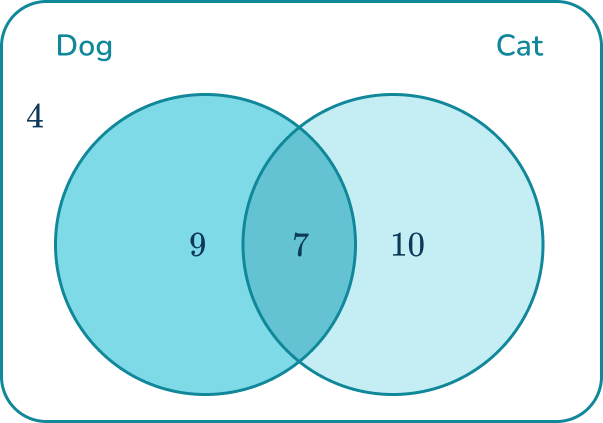
Find the probability that a person selected at random has a cat given that they have a dog.




The desired outcome is that the person has a cat and the condition is that they have a dog. There are 7 people who have both a cat and a dog.
The condition is that the person has a dog. Altogether there are 16 people who have a dog.
The probability that the person has a cat given that they have a dog is \cfrac{7}{16}.
2. The two way table shows information about the gender and age of employees at a company.

A person from the company is chosen at random. Find the probability that the person is female given that they are 30 or over.




The desired outcome is that the person is female and the condition is that they are 30 or over. There are 19 females who are 30 or over.
The condition is that the person is 30 or over. Altogether there are 36 people who are 30 or over.
The probability that the person is female given that they are 30 or over is \cfrac{19}{36}.
3. Lily has the following cards
![]()
Lily picks two cards. The first card is an A. Find the probability that the second card is also an A.




If one A has already been picked, there will be one A left. There will be 7 cards left in total.
The probability that the second card is an A is \cfrac{1}{7}.
4. A football team contains 9 boys and 6 girls. The coach is choosing players at random for a match. The first player picked is a boy. Find the probability that the second player picked is a girl.




If one boy has been picked, there are 8 boys and 6 girls left, giving a total of 14 players. The probability the second player picked is a girl is \cfrac{6}{14}.
5. Ben and Jacob randomly pick a bag of chips from a multipack containing 6 bags of salt and vinegar and 6 packs of sour cream and onion. What is the probability they both pick a bag of salt and vinegar chips? Give the answer in its simplest form.




Using a tree diagram,
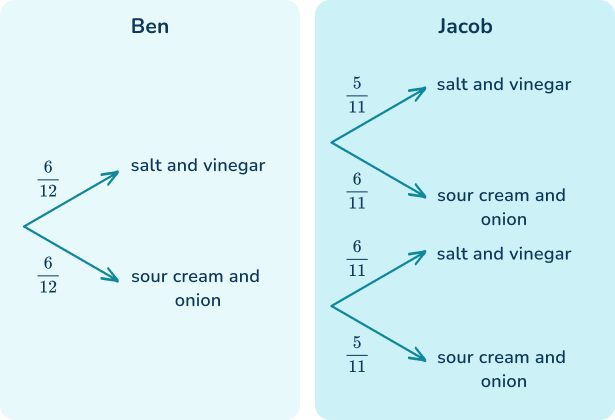
The probability Ben and Jacob pick salt and vinegar is \cfrac{6}{12}\times\cfrac{5}{11}=\cfrac{30}{132}=\cfrac{5}{22}.
6. Fred is a golf player. The probability that Fred gets a hole in one on a dry day is 0.2 and the probability that Fred gets a hole in one on a rainy day is 0.1. Fred is going to play golf tomorrow.
The probability that it will be raining is 0.7. Find the probability that Fred will get a hole in one.




Using a tree diagram,
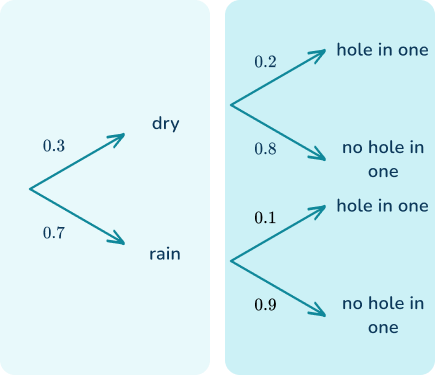
You need to consider the probability of Fred getting a hole in one on a dry day or a rainy day.
The probability that Fred gets a hole in one and it is a dry day is 0.3\times{0.2}=0.06.
The probability that Fred gets a hole in one and it is a wet day is 0.7\times{0.1}=0.07.
The total probability that Fred gets a hole in one on a dry day or a hole in one on a wet day is 0.06+0.07=0.13.
Conditional probability FAQs
Conditional probability is the probability of an event occurring given that another event has already occurred. It is denoted as P(A|B), meaning the probability of event A happening given that event B has happened.
Bayes’ theorem is a mathematical formula that relates the conditional probability of an event to the probabilities of related events.
It is expressed as: P(A|B)=\cfrac{P(B|A)\cdot{P(A)}}{P(B)}.
This theorem helps update the probability of an event based on new evidence.
If you roll a fair six-sided die, the probability of rolling a 3 given that the roll is an odd number (1, 3, 5) is \cfrac{1}{3}.
Conditional probability is the probability of an event occurring given that another event has already occurred. It is denoted as P(A|B).
Unconditional probability (or prior probability/marginal probability) is the probability of an event occurring without any conditions or prior information. It is denoted as P(A).
It represents the probability of event A occurring independently of any other events or conditions.
Yes, conditional probability can involve more than two events.
For example, if you have events A,B, and C, the conditional probability P(A\cap{B}|C) would denote the probability that both events A and B occur given that event C has already occurred.
Similarly, P(A|B\cap{C}) would denote the probability of event A occurring given that both events B and C have already occurred.
The next lessons are
- Compound probability
- Probability distribution
Still stuck?
At Third Space Learning, we specialize in helping teachers and school leaders to provide personalized math support for more of their students through high-quality, online one-on-one math tutoring delivered by subject experts.
Each week, our tutors support thousands of students who are at risk of not meeting their grade-level expectations, and help accelerate their progress and boost their confidence.

Find out how we can help your students achieve success with our math tutoring programs.
[FREE] Common Core Practice Tests (3rd to 8th Grade)
Prepare for math tests in your state with these 3rd Grade to 8th Grade practice assessments for Common Core and state equivalents.
Get your 6 multiple choice practice tests with detailed answers to support test prep, created by US math teachers for US math teachers!